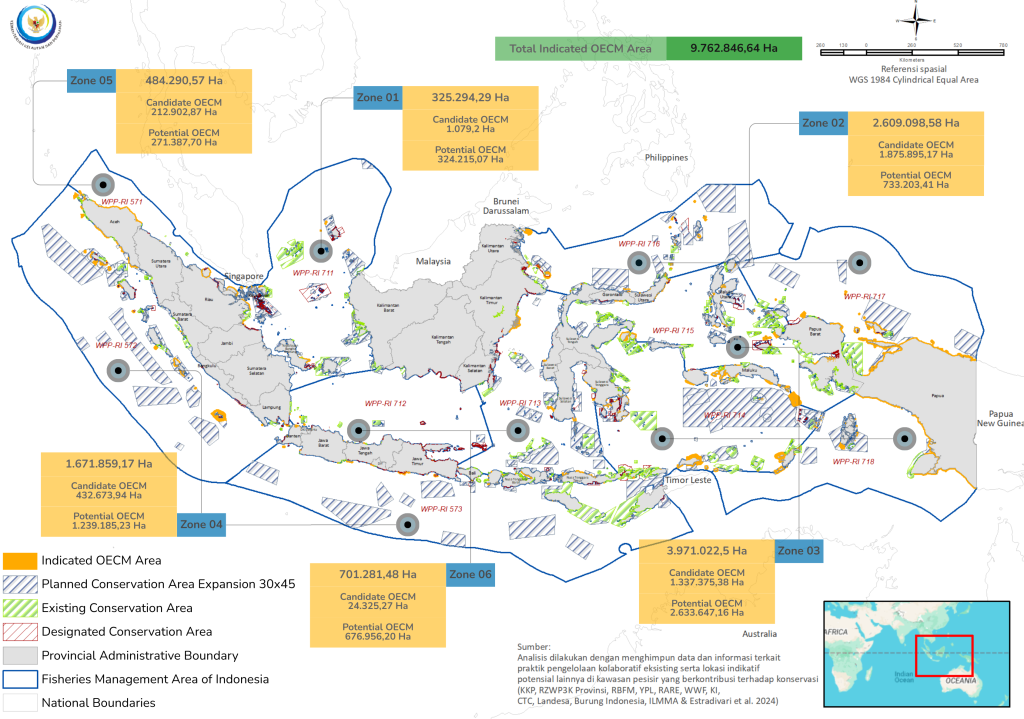What are OECMs?
Other Effective area-based Conservation Measures (OECMs) expand the conservation toolkit beyond Marine Protected Areas (MPAs) by formally recognizing diverse governance systems and stewardship practices. They ensure a more inclusive approach to conservation by respecting traditional tenure systems and cultural practices, while also providing ecological, social, economic, and spiritual benefits. In doing so, OECMs strengthen the resilience of ocean ecosystems and highlight the vital role of local communities as custodians of biodiversity.
The concept of OECMs was introduced in 2010 by the Conference of the Parties to the Convention on Biological Diversity (CBD). In 2018, the Parties formally adopted the following definition:
“a geographically defined area other than a Protected Area, which is governed and managed in ways that achieve positive and sustained long-term outcomes for the in situ conservation of biodiversity, with associated ecosystem functions and services and where applicable, cultural, spiritual, socio–economic, and other locally relevant values”
The International Union for Conservation of Nature (IUCN) has since provided technical guidance to help countries identify and report OECMs consistent with this CBD framework.
Indonesia recognizes OECMs as vital to achieving its target of conserving 30% of marine areas by 2045, complementing MPAs. In March 2024, a multi-stakeholder workshop led by the Ministry of Marine Affairs and Fisheries adopted this national definition:
“Coastal waters and small islands, offshore and deep sea areas that are geographically outside conservation areas, are managed by the government, universities, research institutions, the private sector and/or the community using governance that has an ecological, biodiversity, social, economic and/or cultural conservation impact.”
National terminology refers to these areas as Kawasan Berdampak Konservasi (KBK; Areas with Conservation Impact), or Kawasan Perairan dengan Dampak Konservasi (KPDK; Marine Areas with Conservation Impact) when specifically referring to marine and coastal areas. These may include inland waters, coastal zones, small islands, offshore zones, and deep-sea areas that lie outside formal MPAs but are governed by communities, customary authorities, academic institutions, private sector actors, or government bodies in ways that contribute meaningfully to biodiversity conservation. Indigenous peoples and local communities play a central role, applying customary rules, traditions, and collective agreements that sustain both biodiversity and livelihoods. Recognizing and supporting this stewardship is essential for meeting national and global biodiversity goals.
Traditional Management Systems
Indonesia recognizes traditional marine management systems as important OECMs, including:
Sasi Laut
Sasi Laut is a traditional, customary marine management system practiced in Maluku and parts of eastern Indonesia. The word sasi refers to local rules or prohibitions imposed by communities to protect natural resources—including marine areas—for a specific period.
Awig-Awig
Awig-awig is a form of customary law rooted in traditional community practices, observed in Bali and Lombok. It includes regulations on fishing areas, fishing gear, conservation measures, environmental protection, and sanctions for violations.
Lubuk Larangan
Lubuk larangan, meaning ‘forbidden deep area’ or ‘protected deep pool’, is a traditional community-based fisheries management system practiced in lakes and rivers of West Sumatra and Jambi. It refers to a deep place in a lake, river, or sea—often a preferred habitat or spawning ground for fish—where fishing is prohibited for a certain period through temporary closure rules.
Mane’e
Mane’e is a traditional practice of local wisdom and customary law in North Sulawesi, related to coral reef fisheries management. It involves a community agreement to undertake fishing activities together, with rituals to prepare fishing equipment and carry out the harvest cooperatively. The mane’e ceremony is conducted at specific sites, each with its own name, and is also celebrated as a cultural fishing festival.
Panglima Laot
The panglima laot—literally ‘sea commander’—is a traditional customary marine and fisheries management institution found in Aceh. A respected leader elected from among senior boat captains, the panglima laot enforces customary marine law, resolves disputes among fishers, supervises the use of community fishing grounds, and acts as a liaison between fishing communities and government authorities.
According to the MPA & OECM Vision 2045, four criteria must be met for a site to be considered an OECM Candidate:
- Be located outside government-designated MPAs
- Have established governance and institutional arrangements
- Contain high biodiversity value, with a monitoring plan in place
- Provide significant ecological, social, cultural, or economic benefits
Sites that meet the definition of an OECM and are in accordance with the first criterion and at least one other qualify as Potential OECMs.
Current Status
An OECM definition and criteria have been developed and tested in 10 pilot locations across Indonesia, covering spatial, institutional, biodiversity, and socio-economic and cultural aspects.
Potential OECMs Sites

Based on updated mapping and analysis, approximately 9.763 million hectares of marine areas in Indonesian waters have been identified as OECM Candidates or Potential OECMs. To support biodiversity conservation and the sustainable management of marine resources, the development of a thematic OECM strategy aligns with the three main goals of the 30×45 Vision:
- Marine biodiversity protection
- Sustainable fisheries
- Blue carbon
These categories were derived from an earlier identification process that involved a detailed review of key ecological features and biodiversity across Indonesia’s seascapes. By combining spatial and thematic approaches, this initiative aims to complement the national conservation system and contribute to global biodiversity targets.
As previously outlined, Indonesia’s OECM implementation plan serves as an additional pathway to achieving the 30×45 Vision. Implementation will take place in two phases:
- 199 units (2025–2030) – OECM Candidates
- 451 units (2031–2045) – Potential OECMs